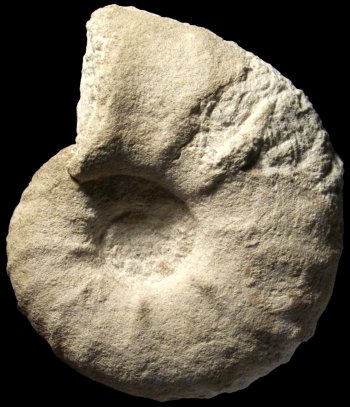

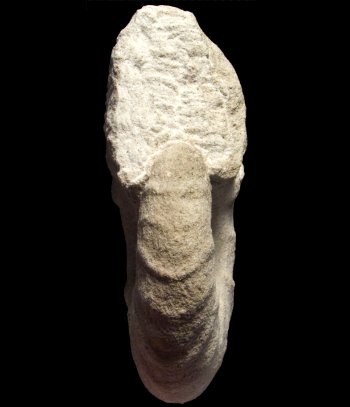

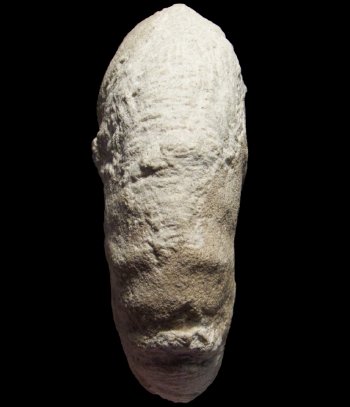


Lewesiceras mantelli Wright & Wright 1951 juv. |
||
Lewesiceras mantelli Wright & Wright 1951 juv.
Étage
Turonien (-92 à -88 millions d'années) supérieur
Localité
Drôme - France
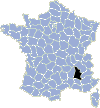
Dimensions
Diamètre = 8,4 cm (3.31")
Commentaire
Classification
Genre :
Lewesiceras Spath 1939
Cénomanien inf. à Turonien sup./?Coniacien inf.
Tours jeunes comparables à ceux d’Eopachydiscus en termes de côtes et constrictions, mais avec des tubercules ombilicaux plus ou moins développés et des côtes plus sinueuses persistant jusqu’à un stade de croissance plus avancé. Tours adultes à tendance lisse, plus comprimée et de plus grande hauteur. Sutures espacées à éléments simples et massifs, moins finement découpés que chez l’ancêtre présumé Eopachydiscus.
Famille :
Pachydiscidae Spath 1922
Albien sup. à Maastrichtien sup.
Dérivent des Desmoceratidae à l’Albien supérieur. Taille moyenne à très grande. Enroulement majoritairement involute ; section déprimée à comprimée ; hauteur importante du tour. Se distinguent des Desmoceratidae par une forte ornementation à certains stades de la croissance. Les côtes traversent généralement le ventre sans interruption et montrent au moins une tendance à la tuberculation ombilicale. Les microconques n’ont pas d’apophyses.
Super-famille :
Desmoceratoidea Zittel 1895
Valanginien supérieur à Maastrichtien supérieur.
Formes à tours de section généralement ronde ou ovale, mais parfois lancéolée ou carénée. Ornementation communément inexistante où formée de faibles côtes, mais certains genres et certaines familles sont fortement costulés et tuberculés. Les constrictions sont communes. Les sutures sont simples à complexes, à lobe suspensif rétracté ou non, lobe latéral symétrique ou trifide asymétrique chez pratiquement tous les groupes. Dimorphisme prononcé. Les macroconques ont une ouverture simple. Les microconques portent des apophyses ou un rostre chez la plupart des familles. Les apophyses semblent absentes chez les Pachydiscidae.
Sous-ordre :
Ammonitina Hyatt 1889
Ordre :
Ammonoidea Zittel 1884
Classe :
Cephalopoda Cuvier 1797
Embranchement :
Mollusca Linnaeus 1758
Super-embranchement :
Bilateria: Protostomia Hatschek, 1888: Grobben 1908
Sous-règne :
Eumetazoa Butschli 1910
Règne :
Animalia Linnaeus 1758
Super-règne :
Eukaryota Whittaker & Margulis 1978
Documents
2019. Kennedy, W., J.
The Ammonoidea of the Upper Chalk. Part 1
in Monograph of the Palaeontographical Society - 173:654, 1-207 - The Palaeontographical Society - London
p 57, pl 13, fig 8-15, 18-26, pl 14, fig 1-13, pl 15, fig 1-5, pl 16, fig 1-5, pl 26, fig 3-5, text-fig 29-33, 34D-F (=Lewesiceras mantelli WRIGHT & WRIGHT, 1951) - lien
2019. Kennedy, W., J. & Kaplan, U.
Ammoniten aus dem Turonium des Münsterländer Kreidebeckens
in Geologie und Paläontologie in Westfalen - Heft 92 - Westfalisches Museum fur Naturkunde
p 39, taf 6, fig 1-13, taf 7, fig 1-2, 4-7, 11-16 (=Lewesiceras mantelli WRIGHT & WRIGHT, 1951) - lien
2018. Baudouin, C., Delanoy, G., Ifrim, C. & Moreno-Bedmar, J., A.
The ammonoid fauna of the Prionocyclus germari Zone (upper Turonian, upper Cretaceous) from Rochefort-en-Valdaine (Drôme, France)
in Carnets de Géologie / Notebooks on Geology - 18 (14)
p 319, pl 3, fig 2, 3, pl 4, fig 1, pl 5, fig 1, 2 (=Lewesiceras mantelli C.W. WRIGHT & E.V. WRIGHT, 1951) - lien
2018. Matrion, B.
Les ammonites
in Amédro, F., Matrion, B. & Robaszynski, F. - Stratotype Turonien - p 183-244 - Museum National d’Histoire Naturelle & Biotope (Patrimoine Géologique ; 8)
p 1992, fig 152A, B, C, 153A (=Lewesiceras mantelli WRIGHT & WRIGHT, 1951)
2015. Kennedy, W., J. & Gale, A., S.
Late Turonian ammonites from Haute-Normandie, France
in Acta Geologica Polonica - Vol. 65, No 4 - Université de Varsovie
p 8, text-fig 5J, K, P-R (=Lewesiceras mantelli WRIGHT & WRIGHT, 1951) - lien
2014. Robaszynski, F., Amédro, F., Devalque, C. & Matrion, B.
Le Turonien des massifs d’Uchaux et de la Cèze (S.E., France) - Migration globale d’ammonites et conséquences sur la zonation internationale, rudistes et corrélations entre les massifs
in Mémoires de la Classe des Sciences - Collection in-4°, IVe série, tome 2, No 2095 - Académie Royale de Belgique
p 133, pl 34, 37, 39 - lien
2014. Wilmsen, M. & Nagm, E.
Ammoniten in "Kreide-Fossilien in Sachsen", Teil 1
in Geologica Saxonica - Journal of Central European Geology - Band 60(1) - Senckenberg
p 205, abb 3c - lien
2012. Diebold, F.
Systematics, biostratigraphy and biogeography of the ammonoid family Collignoniceratidae across the Turonian-Coniacian (Cretaceous) boundary in the West European and Indo-Malgach provinces
University of Heidelberg - PhD Thesis
chap 2, p 146, pl 2
2011. Kennedy, W., J., Amédro, F., Robaszinski, F. & Jagt, J., W., M.
Ammonite faunas from condensed Cenomanan-Turonian sections (’Tourtias’) in southern Belgium and northern France
in Netherlands Journal of Geosciences - Geologie en Mijnbouw - 90 - 2/3 - Royal Geological and Mining Society of the Netherlands (KNGMG) and TNO Built Environment
p 217, fig 9A-C, P-R (cf.)
2006. Fischer, J.-C. (coord.) & al.
Révision critique de la paléontologie française d’Alcide d’Orbigny - Volume IV - Céphalopodes crétacés
Backhuys Publishers, Leiden, Pays-Bas
p 123, pl 62
2004. Wiese, F., Cech, S., Ekrt, B., Kostak, M., Mazuch, M. & Voigt, S.
The Upper Turonian of the Bohemian Cretaceous Basin (Czech Republic) exemplified by the Upohlavy working quarry: integrated stratigraphy and palaeoceanography of a gateway to the Tethys
in Cretaceous Research - 25 (2004) - Academic Press Inc. (London) / Elsevier
p 337
2002. Wright, C., W. & Kennedy, W., J.
Ammonites
in Smith, A., B. & Batten, D., J. - Fossils of the Chalk - Second Edition - Chapter 9 - The Palaeontological Association
p 182, pl 38, fig 1, 2 (=Lewesiceras mantelli WRIGHT and WRIGHT)
1996. Wright, C., W., Callomon, J., H. & Howarth, M., K.
Treatise on Invertebrate Paleontology - Part L : Mollusca 4 Revised - Volume 4 : Cretaceous Ammonoidea
Roger L. Kaesler - Geological Society of America
p 101, pl 78
1995. Colleté, C., Fricot, C., Matrion, M., Tomasson, R. & Treffot, G.
La géologie du département de l’Aube
Association Géologique Auboise
pl XII
1991. Kaplan, U.
Zur Stratigraphie der tiefen Oberkreide im Teutoburger Wald (NW-Deutschland), Teil 2: Turon und Coniac im Steinbruch des Kalkwerks Foerth, Halle, Westfalen
in Bericht des Naturwissenschaftlicher Verein für Bielefeld und Umgegend - 32 - Naturwissenschaftlicher Verein für Bielefeld u. Umgegend
?taf 1, fig 1 (?=Lewesiceras mantelli WRIGHT & WRIGHT 1951)
1982. Tzankov, V.
Les fossiles de Bulgarie - Va - Crétacé supérieur. Cephalopoda (Nautiloidea, Ammonoidea) et Echinodermata (Echinoidea)
Académie Bulgare des Sciences, Sofia
pars. p 33, pl XIV, fig 2, 3 (=Lewesiceras mantelli (WRIGHT & WRIGHT, 1951)), non fig 4
1981. Kennedy, W., J. & Wright, C., W.
Desmoceratacean Ammonites from the Type Turonian
in Palaeontology - Vol. 24, part 3 - The Palaeontological Association
p 500, pl 75, fig 8-11, p 76, fig 3-6 - lien
1981. Wright, C., W. & Kennedy, W., J.
The Ammonoidea of the Plenus Marls and the Middle Chalk
in Monograph of the Palaeontographical Society - Issue 560, part of Volume 134 - The Palaeontographical Society - London
p 31, 32 - lien
1979. Wright, C., W.
The ammonites of the English Chalk Rock (Upper Turonian)
in Bulletin Natural History Museum London (Geol.) - Vol. 31, No. 4 - The Natural History Museum
pl 4, 6 - lien
1974. Blank, M., I., Krimholz, G., I., Naïdin, D., P. & Kavchinskaia, O., B.
Atlas des faunes supracrétacées du Donbass [en Russe]
Ministère de la formation spécialisante supérieure et moyenne de l’U.R.S.S. - Institut fédéral des mines et de la métallurgie - Edition "Nedra", Moscou
p 180, pl 10, fig 5, 6 (?non Lewesiceras cricki (Spath, 1926)), p 180 (=Lewesiceras lenesicense Housa, 1967)
1967. Houša, V.
Lewesiceras Spath (Pachydiscidae, Ammonoidea) from the Turonian of Bohemia
in Sborník geologických věd - řada P . sv. 9 - Česká geologická služby
p 26, pl IV, fig 3, pl V, fig 1-4, pl VI, fig 1-4 (=Lewesiceras mantelli (WRIGHT & WRIGHT, 1951)), p 32, pl VII, fig 1-4 (=Lewesiceras plicatum sp. n.), p 35, pl VIII, fig 1-7 (=Lewesiceras lenesicense sp. n.) - lien
1951. Wright, C., W. & Wright, E., V.
A Survey of the Fossil Cephalopoda of the Chalk of Great Britain
The Palaeontographical Society
p 20, pl X, fig 3
1950. Sornay, J.
Étude stratigraphique sur le Crétacé supérieur de la Vallée du Rhône entre Valence et Avignon et des régions voisines - Thèse de Doctorat ès Sciences Naturelles
Université de Grenoble
p 38 (=Pachydiscus sp. juv. aff. peramplus Mant.), 39 (=Pachydiscus sp. (Lewesiceras ?))
1853. Sharpe, D.
Description of the fossil remains of Mollusca found in the chalk of England. Part I. Cephalopoda.
The Palaeontographical Society
pl X, fig 3 (non Ammonites peramplus)
Contenu révisé le 22 janvier 2024 - Fiche générée le 22 janvier 2024 - 1ère publication le 1er mai 2010

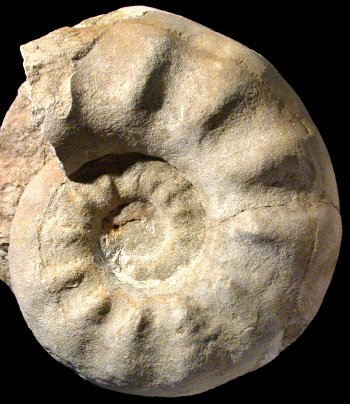
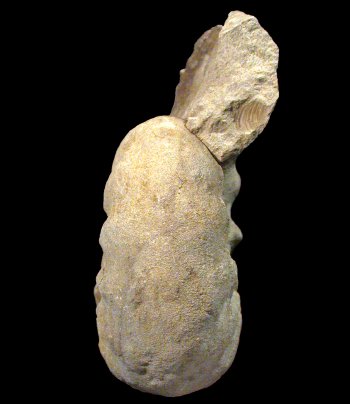
Individu de la zone à Germari., figuré dans Diebold, 2012 et dans Baudouin & al., 2018.
Jeune ou nucleus permettant de voir l’ornementation des tours internes, malgré une certaine compression post-mortem.
Espèce du Turonien supérieur, de la zone à Deverianum jusqu’à la zone à Germari en Europe du nord-ouest, centrale et de l’est.
Wright & Wright ont donné le nom d’espèce mantelli aux Lewesiceras du Turonien supérieur apparentés à Lewesiceras peramplum (Turonien inférieur et moyen). L. peramplum, possède, à mi-croissance, une hauteur de tour et une compression supérieures, ainsi que des tubercules ombilicaux moins proéminents et moins épineux, mais le critère le plus fiable de différenciation est la rétention de côtes intercalaires chez peramplum à un stade de croissance où elles ont disparu chez mantelli (Kennedy 2019).